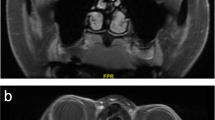Abstract
Neuro-ophthalmologic emergencies consist of neurologic disorders with ocular involvement. These conditions often require urgent imaging, consultation, and treatment. The ophthalmologic presentation along with associated features can guide the emergency physician in localizing the underlying process and subsequent management. This chapter evaluates these conditions, with associated emergency evaluation and management.
Access this chapter
Tax calculation will be finalised at checkout
Purchases are for personal use only
Similar content being viewed by others
References
Walker RA, Adhikaris. Eye emergencies. In: Tintinalli’s emergency medicine: a comprehensive study guide. 8th ed. Columbus: Mcgraw-Hill; 2016. Chap. 241.
Huff JS, Austin EW. Neuro-ophthalmology in emergency medicine. Emerg Med Clin North Am. 2016;34:967–86.
Cordonnier M, Van Nechel C. Neuro-ophthalmological emergencies: which ocular signs or symptoms for which diseases? Acta Neurol Belg. 2013;113:215–24.
Graves JS, Galetta SL. Acute visual loss and other neuro-ophthalmologic emergencies: management. Neurol Clin. 2012;30:75–99.
Zhang X, Kedar S, Lynn MJ, et al. Homonymous hemianopias: clinical-anatomic correlations in 904 cases. Neurology. 2006;66:906.
Kawasaki A, Purvin V. Giant cell arteritis: an updated review. Acta Ophthalmol. 2009;87:13–32.
Smetana GW, Shmerling RH. Does this patient have temporal arteritis? JAMA. 2002;287:92–101.
Biousse V, Newman NJ. Ischemic optic neuropathies. N Engl J Med. 2015;372:2428–36.
Balcer LJ. Clinical practice. Optic neuritis. N Engl J Med. 2006;354:1273–80.
Arnold AC. Evolving management of optic neuritis and multiple sclerosis. Am J Ophthalmol. 2005;139:1101–8.
Golnik KC. Infectious optic neuropathy. Semin Ophthalmol. 2002;17:11–7.
Hollands H, Johnson D, Brox AC, et al. Acute-onset floaters and flashes: is this patient at risk for retinal detachment? JAMA. 2009;302:2243–9.
Charles A. Advances in the basic and clinical science of migraine. Ann Neurol. 2009;65:491–8.
Cutrer FM, Huerter K. Migraine aura. Neurologist. 2007;13:118–25.
Stone J, Carson A, Sharpe M. Functional symptoms and signs in neurology: assessment and diagnosis. J Neurol Neurosurg Psychiatry. 2005;76(Suppl 1):i2–12.
Beatty S. Non-organic visual loss. Postgrad Med J. 1999;75:201–7.
Lee SH, Lee SS, Park KY, Han SH. Isolated oculomotor nerve palsy: diagnostic approach using the degree of external and internal dysfunction. Clin Neurol Neurosurg. 2002;104:136.
Chaudhary N, Davagnanam I, Ansari SA, et al. Imaging of intracranial aneurysms causing isolated third cranial nerve palsy. J Neuroophthalmol. 2009;29:238–44.
Walton KA, Buono LM. Horner syndrome. Curr Opin Ophthalmol. 2003;14:357–63.
Bone I, Hadley DM. Syndromes of the orbital fissure, cavernous sinus, cerebello-pontine angle, and skull base. J Neurol Neurosurg Psychiatry. 2005;76(Suppl 3):iii29–38.
Ebright JR, Pace MT, Niazi AF. Septic thrombosis of the cavernous sinuses. Arch Intern Med. 2001;161:2671–6.
Randeva HS, Schoebel J, Byrne J, et al. Classical pituitary apoplexy: clinical features, management and outcome. Clin Endocrinol. 1999;51:181–8.
Capatina C, Inder W, Karavitaki N, Wass JA. Management of endocrine disease: pituitary tumour apoplexy. Eur J Endocrinol. 2015;172:R179–90.
Arafah BM, Harrington JF, Madhoun ZT, Selman WR. Improvement of pituitary function after surgical decompression for pituitary tumor apoplexy. J Clin Endocrinol Metab. 1990;71:323–8.
Wall M, Kupersmith MJ, Kieburtz KD, et al. The idiopathic intracranial hypertension treatment trial: clinical profile at baseline. JAMA Neurol. 2014;71:693–701.
Biousse V, Bruce BB, Newman NJ. Update on the pathophysiology and management of idiopathic intracranial hypertension. J Neurol Neurosurg Psychiatry. 2012;83:488–94.
Silvestri NJ, Wolfe GI. Myasthenia gravis. Semin Neurol. 2012;32:215–26.
Meriggioli MN, Sanders DB. Autoimmune myasthenia gravis: emerging clinical and biological heterogeneity. Lancet Neurol. 2009;8:475.
Donnino MW, Vega J, Miller J, Walsh M. Myths and misconceptions of Wernicke’s encephalopathy: what every emergency physician should know. Ann Emerg Med. 2007;50:715–21.
Galvin R, Bråthen G, Ivashynka A, et al. EFNS guidelines for diagnosis, therapy and prevention of Wernicke encephalopathy. Eur J Neurol. 2010;17:1408–18.
Author information
Authors and Affiliations
Editor information
Editors and Affiliations
Rights and permissions
Copyright information
© 2018 Springer International Publishing AG, part of Springer Nature
About this chapter
Cite this chapter
Webb, J.L., Long, B. (2018). Neuro-ophthalmologic Emergencies. In: Long, B., Koyfman, A. (eds) Handbook of Emergency Ophthalmology. Springer, Cham. https://doi.org/10.1007/978-3-319-78945-3_11
Download citation
DOI: https://doi.org/10.1007/978-3-319-78945-3_11
Published:
Publisher Name: Springer, Cham
Print ISBN: 978-3-319-78944-6
Online ISBN: 978-3-319-78945-3
eBook Packages: MedicineMedicine (R0)




